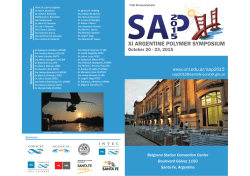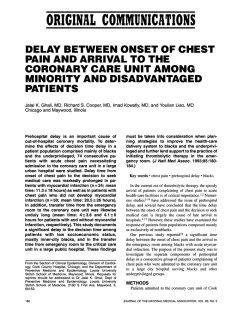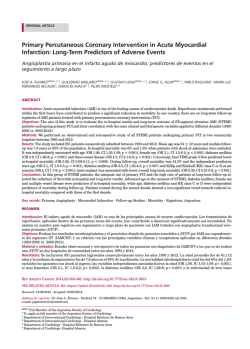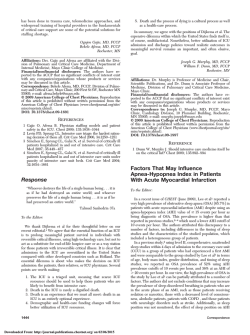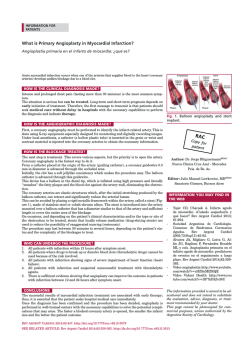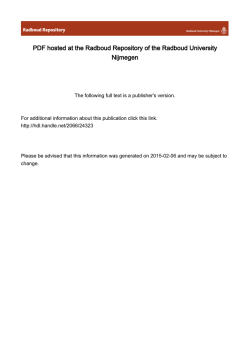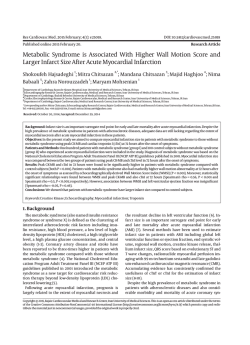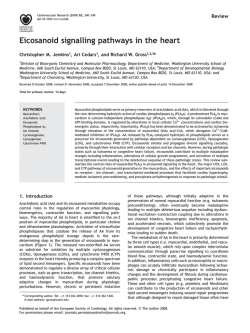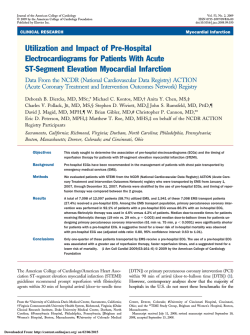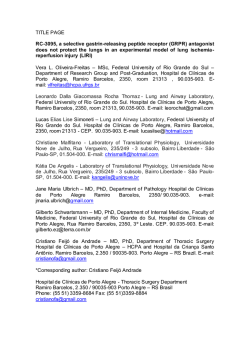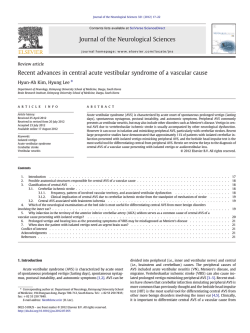
Quality of Care for acute Myocardial infarction in argentina
ORIGINAL ARTICLE CME Quality of Care for Acute Myocardial Infarction in Argentina. Observations from the SCAR (Acute Coronary Syndromes in Argentina) Registry Calidad de atención del infarto agudo de miocardio en la Argentina. Observaciones del Registro SCAR (Síndromes Coronarios Agudos en Argentina) HORACIO E. FERNÁNDEZ†, 1, JORGE A. BILBAO†, 1, HERNÁN COHEN ARAZIMTSAC, MARÍA L. AYERDI1, JUAN M. TELAYNAMTSAC, 1, ERNESTO A. DURONTOMTSAC, 2, RICARDO VILLARREALMTSAC, 3, PATRICIA BLANCOMTSAC, 4, CLAUDIO HIGAMTSAC, 5, in representation of the SCAR Multicenter Registry, SAC Research Area and Cardiovascular Emergency CouncilMTSAC ABSTRACT Introduction: Quality assessments help to quantify the gap between healthcare provision and what should be awarded. There are specific measurements on quality of medical care for myocardial infarction which standardize the quality information that every institution should determine for self-assessment and for comparison with others. Objective: The aim of this study was to analyze quality of care for myocardial infarction data in our country using the SCAR (Acute Coronary Syndromes in Argentina) Multicenter Registry. Methods: Quality of care data for myocardial infarction was analyzed in patients included in the database of the SCAR Multicenter Registry using definitions of the “ACC/AHA 2008 performance measures for adults with ST-elevation and non-ST-elevation myocardial infarction” document. Results: The study analyzed 751 myocardial infarction cases with complete data on quality indicators. Aspirin, betablockers, statins and angiotensin antagonists were used in nearly 90% of patients. The exception was clopidogrel which was used in 72.5% of patients not receiving mechanical reperfusion. Ventricular function was assessed during hospitalization in 90.2% of cases. A reperfusion strategy was used in 90.1% of ST-segment-elevation infarctions and less than 12-hour evolution. Door-to-balloon time was < 90 minutes in 50.8% of cases, while door-to-needle time was < 40.5%. Conclusions: Overall, there was high compliance to pharmacological and reperfusion treatments except in the use of clopidogrel without mechanical revascularization, and low compliance to the appropriate times of reperfusion therapy. Key words: Myocardial infarction - Myocardial reperfusion – Balloon angioplasty - Thrombolytic therapy – Healthcare quality. RESUMEN Introducción: Las mediciones de calidad ayudan a cuantificar la distancia entre la atención en salud que se brinda y la que se debería brindar. Existen mediciones específicas sobre la calidad de la atención del infarto de miocardio que permiten uniformar los datos de calidad que toda institución debería medir para autoevaluarse y compararse con otras. Objetivo: Analizar los datos de calidad de la atención del infarto en nuestro país utilizando los datos del Registro Multicéntrico SCAR (Síndromes Coronarios Agudos en Argentina). Material y métodos: Se analizaron los datos de calidad de atención del infarto de miocardio de los pacientes de la base de datos del Registro Multicéntrico SCAR utilizando definiciones del documento “ACC/AHA 2008 performance measures for adults with STelevation and non-ST-elevation myocardial infarction”. Resultados: Se analizaron 751 casos de infarto de miocardio con datos completos sobre indicadores de calidad. El uso de aspirina, betabloqueantes, estatinas y antagonistas de la angiotensina fue cercano al 90%. La excepción fue el uso de clopidogrel, que fue del 72,5% en quienes no recibieron reperfusión mecánica. Se relevó la función ventricular durante la internación en el 90,2% de los casos. Recibieron alguna estrategia de reperfusión el 90,1% de los infartos con elevación del segmento ST y menos de 12 horas de evolución. El tiempo puerta-balón fue < 90 minutos en el 50,8% de los casos, mientras que el tiempo puerta-aguja fue < 30 minutos en el 40,5%. Conclusiones: Globalmente se observaron valores altos de cumplimiento en los tratamientos farmacológicos y de reperfusión, excepto en el uso de clopidogrel sin revascularización mecánica. Se observó un cumplimiento bajo en los tiempos apropiados de los tratamientos de reperfusión. Palabras clave: Infarto del miocardio - Reperfusión miocárdica - Angioplastia coronaria con balón - Terapia trombolítica - Calidad de atención en salud. REV ARGENT CARDIOL 2014;82:352-358. http://dx.doi.org/10.7775/rac.v82.i5.3358 Received: 10/29/2013 Accepted: 04/09/2014 Address for reprints: Dr. Horacio Fernández - Hospital Universitario Austral - Instituto de Cardiología, Unidad de Cardiología Crítica Av. J. D. Perón 1500 - (B1629AHJ) Derqui, Pilar - Pcia. de Buenos Aires, Argentina - e-mail: [email protected] MTSAC Full Member of the Argentine Society of Cardiology To apply as Full Member of the Argentine Society of Cardiology 1 Hospital Universitario Austral 2 Fundación Favaloro 3 Sanatorio Güemes 4 Hospital Naval 5 Hospital Alemán † 353 QUALITY OF CARE FOR ACUTE MYOCARDIAL INFARCTION / Horacio Fernández et al. Abbreviations ACC American College of Cardiology AHA American Heart Association SAC Argentine Society of Cardiology INTRODUCTION It has been over 10 years since the United States Institute of Medicine documented its concerns on the quality of care implemented in healthcare institutions. (1) However, few healthcare institutions in our country measure and report, either internally or to the public, indicators on their quality of care. (2) Neither are there national public health initiatives to encourage such reports as in other countries. (3) Private initiatives reporting on healthcare quality indicators do not yet contemplate myocardial infarction. (4) Quality measurements help quantify the gap between healthcare provision and what should be awarded. Identifying this gap in the field of our daily work would develop strategies to improve standards of care by comparing them with other centers (benchmarking). On the other hand, especially in the United States, public health institutions make these quality measurements spontaneously or upon request of the State or accrediting agencies such as the Joint Commission International. (5-7) The American College of Cardiology (ACC) and the American Heart Association (AHA) have developed indicators to measure the quality of cardiovascular care in various clinical settings, including acute myocardial infarction. (8) These indicators standardize the way in which quality of care in different institutions is measured and compared. Measurement processes are based on the recommendations of the ACC/AHA Class I guidelines for the management of acute myocardial infarction, (9) simplifying the task of transferring the reported scientific evidence to the real world clinical practice. In our setting, there have been local initiatives to measure the quality of the public health integrated system in the Autonomous City of Buenos Aires for the care of myocardial infarction. (10) Time to reperfusion in a network of public hospitals in the south of Buenos Aires province has also been reported. (11) Joining these initiatives, our goal was to evaluate the quality of care for myocardial infarction in national centers participating in the SCAR Multicenter Registry (Acute Coronary Syndromes in Argentina) conducted by the Research Area and the Cardiovascular Emergency Council of the Argentine Society of Cardiology METHODS Population and Design Data was collected from the observational, prospective, cross-sectional consecutive registry which included patients with a diagnosis of acute coronary syndrome in 87 centers from Argentina (Appendix) between March and October 2011. Patients with myocardial infarction defined as the presence of ischemic pain of ≥ 20 minute duration with char- STEMI SCAR NSTEMI ST-segment elevation myocardial infarction Acute Coronary Syndromes in Argentina Non-ST-segment elevation myocardial infarction acteristic ischemic electrocardiographic changes and biochemical marker elevation twice the upper limit of normal were included for the analysis of quality of care. ST-segment elevation myocardial infarctions (STEMI) were defined as those presenting persistent ST-segment elevation ≥ 1 mm in two or more contiguous leads considered to be ischemic. The rest were classified as non-ST-segment elevation myocardial infarctions (NSTEMI). Clinical, diagnostic and therapeutic interventions were recorded at each data center and sent in a specially designed file for the study via the Internet or by mail to the SAC Research Area. The study was conducted in agreement with Good Clinical Practice Guidelines and the Data Protection Law of Argentina. The protocol was approved by the SAC Bioethics Committee. Due to the observational nature of the registry, behaviors and treatments were adopted according to each investigator’s criteria. Definition of indicators Definitions of the ACC/AHA published in their 2008 document “Performance measures for adults with ST-segment elevation and non-ST-segment elevation myocardial infarction” (Table 1) were used. (8) Statistical analysis Continuous variables are presented as mean ± standard deviation or median and interquartile range, depending on normal or non-normal distribution. Student´s t test, Kruskal-Wallis test and Wilcoxon rank-sum test were used as appropriate to compare groups.. A simple regression analysis was performed to obtain raw coefficients. A p value < 0.05 was considered as statistically significant. Analyses were performed using the Epi Info® public domain statistical software from the Centers for Disease Control and Prevention (CDC). RESULTS The Registry was active between March and October 2011, collecting data from 1330 patients with acute coronary syndrome in 87 centers from Argentina. For these analyses 751 out of 758 cases had infarctions that presented proper and complete data for the expected quality assessment. Mean age was 61 ± 12 years and 23% of patients were female. STEMI patients had a higher prevalence of smoking, whereas NSTEMI ones had a higher prevalence of other risk factors. Moreover, the latter group presented a larger number of cases with history of myocardial infarction and prior revascularization. The rest of the population characteristics are shown in Table 2. Overall and individual quality results, for STEMI and NSTEMI patients are shown in Table 3. Nearly all patients received adequate medical therapy at admission and discharge, with utilization rates above 90%, with the exception of antiangiotensin strategies (angiotensin-converting enzyme inhibi- 354 ARGENTINE JOURNAL OF CARDIOLOGY / VOL 82 Nº 5 / OCTOBER 2014 Table 1. Definitions, inclusions and exclusions of the measured quality indicators Numerator Variable Aspirin at admission Patients receiving ASA at admission or Denominator All infarctions who had been receiving it Exclusion Deceased on the day of admission Allergy to aspirin or other contraindications Aspirin at discharge Patients receiving ASA at discharge All infarctions Referred or deceased prior to discharge Allergy or other contraindications Betablockers at discharge Patients receiving betablocker All infarctions treatment at discharge Referred or deceased prior to discharge Allergy or other contraindications Statins at discharge Patients receiving statin treatment All infarctions at discharge Referred or deceased prior to discharge LDL < 100, allergy or other contraindications Ventricular function Patients with any method of LV assessment function assessment ARB in LV dysfunction ARB at discharge in patients with Infarctions with moderate Referred or deceased prior to moderate to severe LV to severe LV dysfunction discharge All infarctions Referred or deceased prior to discharge dysfunction Allergy, aortic stenosis, angioedema, hyperkalemia, hypotension, renal Door-to-needle time ≤ 30 minutes artery stenosis, renal dysfunction Patients undergoing thrombolytic STEMI receiving thrombolytics Referred from another institution therapy within ≤ 30 minutes from ≤ 6 hours from arrival to the Documented contraindication Door-to-ballon time ≤ 90 admission to the healthcare center healthcare center minutes Patients undergoing angioplasty STEMI with direct angioplasty Referred from another institution within ≤ 90 minutes from admission performed within 24 hours from Patients who received thrombolytics. to the healthcare center admission Documented reason for no Patients who received or were referred STEMI within 12 hours from Documented reason for no Clopidogrel at discharge in for some type of reperfusion initiation of symptoms reperfusion medical treatment Patients without mechanical revascu- All infarctions Patients undergoing angioplasty or Reperfusion reperfusion larization procedures receiving CABG during hospitalization or that clopidogrel or ticlopidine at discharge were planned at discharge Deceased or referred. Allergy ASA: acetylsalicylic acid (aspirin). LV: Left ventricular. ARB: Angiotensin Receptor Blocker. AIIRA: Angiotensin II receptor antagonists. STEMI: STsegment elevation myocardial infarction. LDL: Low-density lipoprotein. CABG: Coronary artery bypass graft surgery. tors and angiotensin receptor blockers), which were a little below that figure, as was the use of clopidogrel at discharge in those who did not receive mechanical revascularization. A reperfusion strategy was used in 89.3% of STEMI cases. However, when the quality indicator definition is applied and patients with less than 12 hours evolution are assessed, the figure stands at 90.1%. Regarding the type of reperfusion therapy used in that temporal window, direct angioplasty was performed in 61.7% and thrombolytic treatment was used in 19.3% of cases. The quality of reperfusion analysis showed that only half of the patients received direct angioplasty in an optimal door-to-treatment time below 90 minutes, and only 40.5% of patients received thrombolytic therapy in the recommended time interval below 30 minutes. Ventricular function assessment during hospitalization was performed in 90.2% of patients. Overall stroke mortality was 7.2% with no significant difference between STEMI and NSTEMI patients. 355 QUALITY OF CARE FOR ACUTE MYOCARDIAL INFARCTION / Horacio Fernández et al. Performance measurement Aspirin at admission Aspirin at discharge Betablockers at discharge Statins at discharge LV function measurement Antiangiotensin in LV dysfunction Door-to-balloon < 90 min Door-to-needle < 30? min Reperfusion with < 12 hour symptoms Clopidogrel at discharge with medical treatment Mortality Overall (n = 751) n (%) With STE (n = 472) n (%) With NSTE (n = 279) n (%) p 743/747 (99.5) 690/693 (99.6) 635/670 (94.8) 658/679 (96.9) 629/697 (90.2) 133/151 (88.1) 466/469 (99.4) 430/432 (99.5) 392/417 (94.0) 412/423 (97.4) 389/435 (89.4) 89/100 (89.0) 277/278 (99.6) 260/261 (99.6) 243/253 (96.0) 246/256 (96.1) 240/262 (91.6) 44/51 (86.3) ns ns ns ns ns ns Table 2. Quality of care indicators for myocardial infarction 129/254 (50.8) 30/74 (40.5) 353/392 (90.1) 87/120 (72.5) 48/59 (81.4) 39/61 (63.9) 0.033 54/751 (7.2) 37/472 (7.8) 17/279 (6.1) ns STE: ST segment elevation. NSTE: Non-ST-segment elevation. ns: Non-significant Age, years Female gender Obesity Hypertension Smoking Diabetes Dyslipidemia Family history Previous infarction Previous revascularization Direct angioplasty Thrombolytic therapy Overall (n = 751) n (%) With STE (n = 472) n (%) With NSTE (n = 279) n (%) p 62 ± 12 175 (23.3) 215 (28.6) 498 (66.3) 279 (37.1) 166 (22.1) 398 (53.0) 126 (16.8) 133 (17.7) 123 (16.4) 61 ± 12 117 (24.8) 135 (28.6) 299 (63.3) 191 (40.5) 90 (19.1) 233 (49.4) 87 (18.4) 60 (12.7) 56 (11.9) 291 (61.7) 91 (19.3) 63 ± 12 58 (20.8) 80 (37.4) 198 (71.0) 89 (31.8) 76 (27.2) 165 (59.1) 39(14.0) 73 (26.2) 67 (24.0) 0.022 ns ns 0.03 0.02 0.01 0.01 ns < 0.001 < 0.001 Table 3. Population characteristics STE: ST-segment elevation. NSTE: Non-ST-segment elevation. ns: Non-significant. DISCUSSION The reduction in mortality achieved through the years in the treatment of myocardial infarction is due to pharmacological and mechanical interventions aimed at limiting thrombosis, infarct size, arrhythmias and subsequent myocardial remodeling. (12, 13) In contrast, delayed reperfusion increases mortality of patients who have lost this benefit. (14) This is evidenced in a recently published registry of 515 hospitals participating of the CathPCIRegistri showing that mortality of patients with direct angioplasty in less than 90 minutes was 3.7%, whereas in those exceeding that time mortality was 7.3%, similar to that of our study. (15) Quality indicators allow assessing the implementation of guideline recommendations in everyday clinical practice to see how far our setting is from the best quality of care. In that sense, our results show a proper use of initial and at discharge patient treatment. Regarding the use of aspirin, beta blockers and statins, our figures match those of Piombo et al. (10) that showed 97.8%, 92.6% and 95.6% utilization, respectively. Similarly, the same study shows less use of strategies that block the effect of angiotensin in patients with ventricular dysfunction, reporting 88.2% utilization. Clopidogrel administration in patients not receiving mechanical reperfusion was also lower in our study, especially in NSTEMI patients. This indicates lack of knowledge or adherence to guideline recommendations based on studies of clopidogrel in myocardial infarction. (16-18) It is possible to improve these values with medical education and information dissemination. In selected centers participating in the SCAR Registry, the use of any type of reperfusion strategy achieved very acceptable values (90.1%), better than previously reported results in myocardial infarction surveys in Argentina showing prevalence of 74 % and 55% in 2003 and 2005. (19) These results had already shown improvements in the Piombo et al. study (10) reporting 95.2% use of reperfusion and the Mariani et al. study, (11) with 63.6% utilization. It seems that 356 ARGENTINE JOURNAL OF CARDIOLOGY / VOL 82 Nº 5 / OCTOBER 2014 there is an opportunity for improvement for 5-10% of patients who are still not receiving any reperfusion strategy, considering that this value could be higher if all health centers in the country were taken into account. Myocardial infarction in our registry, especially STEMI, was lower than in previous registries, 7.8% vs. 10% in the 2005 SAC survey, although substantially higher than the 3% prevalence indicated by the city of Buenos Aires hospital study and the 4.6% in the south of Buenos Aires province hospital study. The most upsetting aspect of our results in terms of reperfusion quality lies in the delay to perform it. Only about half of patients are reperfused in the ideal times indicated by guidelines. Similar difficulties were found in the already mentioned hospital study in the city of Buenos Aires, showing that only 1 out of every 3 patients undergo reperfusion treatment in the ideal time. Thus, projects of quality improvement should be focused here, encouraging strategies to improve early diagnosis (electrocardiogram within 10 minutes) and quick access to thrombolytic therapy in the emergency room, or prompt assistance of the hemodynamics team and transfer of the patient to the ward, perfecting communications, and promoting the use of thrombolytics when it is known that angioplasty will not be achieved in less than 90 minutes, either by inherent center problems or because transfer to try direct angioplasty is intended. These are the elements that will allow infarct mortality rate to continue decreasing. In the United States, most of the institutions are required to make public their data on quality of care. They are published on the Internet and are useful to compare among different institutions or one institution with the national standard. Figure 1 shows data of our registry compared with the national average of the United States during the same period. (20) It can 100 100 100 97 95 90 88 90 80 70 60 50 99 100 98 97 96 51 93 40 90 41 60 30 20 78 10 y hs ta or M < lit 12 30 < us pe rf < 90 DN dy DB sfu isc LV B Re AR di in sd at St k oc bl ta Be nc . h h sc sc di A AS AS A ad m h 0 SCAR USA Fig. 1. Comparison between the Multicenter SCAR Registry results and the USA national mean. ASA: Acetylsalicylic acid (aspirin). Bblock: Betablockers. DB: Door-to-balloon time. DN: Door-toneedle time. ARB: Angiotensin Receptor Blockers. be noticed that the results of the United States are similar to those of our registry, except for the times to reperfusion which are clearly better in the North American country. Study limitations As this was a survey study, the data obtained were dependent on the commitment of each center (for logistical reasons there was no available audit of the 87 centers). The methodology for door-to-balloon and door-to-needle data collection was not standardized. There may be a bias towards approximation and rounding of those times. Participating centers are associated to SAC; half of them have cardiology residency and 75% have 24-hour hemodynamics capacity, so that the data arising from this registry may not reflect the country’s reality. CONCLUSIONS The impact of scientific evidence and guidelines of cardiological societies reflects positively on the high rate of appropriate pharmacological treatments and reperfusion use in this sample of coronary care units in Argentina. However, low compliance of appropriate and timely use of some form of reperfusion therapy opens a great opportunity of improvement that should be prioritized in the coming years. Conflicts of interest None declared. REFERENCES 1. Institute of Medicine, Committee on Quality of Health Care in America. Crossing the Quality Chasm: A New Health System for the 21st Century. Washington, DC: Institute of Medicine; 2001. 2. http://www.picam.org.ar/. Adhesión al programa de hospitales públicos e instituciones privadas. 3. “Health Policy Brief: Public Reporting on Quality and Costs”, Health Affairs, March 8, 2012. 4. Programa de Indicadores de Calidad en la Atención Médica de SACAS (Sociedad Argentina de Calidad en Atención de la Salud) / ITAES (Instituto Técnico para la Acreditación de Establecimientos de Salud). http://www.calidadensalud.org.ar/ 5. http://www.medicare.gov/hospitalcompare 6. http://www.jointcommission.org/core_measure_sets.aspx 7. QualityNet. Specifications manual for national hospitality quality measures. Version 4.2 (http://www.qualitynet.org/dcs/ contentServer?pagename=QnetPublic%2FPage%2FQnetTier2&c id=1141662756099). 8. ACC/AHA 2008 Performance Measures for Adults With ST-Elevation and Non-ST Elevation Myocardial Infarction. Circulation 2008;118;2596-648. 9. ACC/AHA Guidelines for the Management of Patients With STElevation Myocardial Infarction. Circulation 2004;110:e82-e292. 10. Piombo A, Rolandi M, Fitz Maurice M, Salzberg S, Zylberstein H, Rubio E y colset al. Registry of Quality of Medical Care for Acute Myocardial Infarction at Buenos Aires Public HospitalsRegistro de calidad de atención del infarto agudo de miocardio en los hospitales públicos de la ciudad de Buenos Aires. Rev Argent Cardiol 2011;79:132-8. 11. Mariani J, De Abreu M, Tajer C, en representación de los investigadores de la Red para la Atención de los Síndromes Coronarios Agudos. Time to and Use of Reperfusion Therapy in a Health Care NetworkTiempos y utilización de terapia de reperfusión en un sistema de atención en red. Rev Argent Cardiol 2013;81:233-9. http://doi. org/s2r QUALITY OF CARE FOR ACUTE MYOCARDIAL INFARCTION / Horacio Fernández et al. 12. McManus DD, Gore J, Yarzebski J, Spencer F, Lessard D, Goldberg RJ. Recent trends in the incidence, treatment, and outcomes of patients with STEMI and NSTEMI. Am J Med 2011;124:40-7. http:// doi.org/dhgcz2 13. Jernberg T, Johanson P, Held C, Svennblad B, Lindback J, Wallentin L. Association between adoption of evidence-based treatment and survival for patients with ST-elevation myocardial infarction. J Am Med Assoc 2011;305:1677-84. http://doi.org/fkn5jk 14. Terkelsen CJ, Sørensen JT, Maeng M, Jensen LO, Tilsted HH, Trautner S, et al. System delay and mortality among patients with STEMI treated with primary percutaneous coronary intervention. JAMA 2010;18;304:763-71. 15. Menees D, Peterson ED, Wang Y, Curtis JP, Messenger JC, Rumsfeld JS, et al. Door-to-balloon time and mortality among patients undergoing primary PCI. N Engl J Med 2013;369:901-9. http://doi. org/dkdfgd 16. The clopidogrel in unstable angina to prevent recurrent events 357 trial investigators. Effects of clopidogrel in addition to aspirin in patients with acute coronary syndromes without ST-segment elevation. N Engl J Med 2001;345:494-502. 17. Chen ZM, Jiang LX, Chen YP, Xie JX, Pan HC, Peto R, et al. Addition of clopidogrel to aspirin in 45,852 patients with acute myocardial infarction: randomized placebo-controlled trial. Lancet 2005;366:1607-21. 18. Sabatine MS, Cannon CP, Gibson CM, Lopez-Sendon JL, Montalescot G, Theroux P, et al. Addition of clopidogrel to aspirin and fibrinolytic therapy for myocardial infarction with ST-segment elevation. N Engl J Med 2005;352:1179-89. http://doi.org/cfvngk 19. Gagliardi J, Charask A, Higa C, Blanco P, Dini A, Tajer C y colset al. Acute Myocardial Infarction. Results from the SAC 2005 Survey in the ArgentineInfarto agudo de miocardio en la República Argentina. Análisis comparativo en los últimos 18 años. Resultados de las Encuestas SAC. Rev Argent Cardiol 2007;75:171-8. 20. http://www.medicare.gov/hospitalcompare APPENDIX Participating centers and responsible investigators of the SCAR Registry 1. Asociación Española de Socorros Mutuos (Comodoro Rivadavia): Dr. Celia, José Carlos | Dr. Freile, Oscar 2. CEMEP Río Grande (Tierra del Fuego): Dr. Grane, Ignacio | Dra. Di Nunzio, Mariela 3. CEMIC: Dr. Fuselli, Juan | Dr. Guetta, Javier 4. Centro Cardiológico del Norte: Dr. Cravzov, Ricardo | Dra. Mereles, Laura 5. Centro Gallego: Dr. Varini, Sergio | Dra. Surc, Patricia 6. Clínica Bazterrica: Dr. Barrero, Carlos | Dra. Granada, Carolina 7. Clínica Coronel Suárez: Dr. Caccavo, Alberto | Dr. Sein, Mariano 8. Clínica Comahue: Dr. López, Enrique 9. Clínica del Sol: Dr. Gagliardi, Juan 10. Clínica del Valle (Comodoro Rivadavia): Dra. Seleme, María | Dr. Gil Daroni, Juan 11. Clínica Independencia: Dr. Pomés Iparraguirre, Horacio | Dr. de Dominicis, Francisco 12. Clínica La Sagrada Familia: Dr. Ingino, Carlos 13. Clínica Modelo Morón: Dra. Salvati, Ana María | Dra. Gentile, Silvia 14. Clínica Olivos: Dr. Nani, Sebastián | Dr. Guardiani, Fernando 15. Clínica Privada ERI: Dr. Campos, Carlos | Dra. Panetta, Analía 16. Clínica San Camilo: Dr. David, José María | Dr. Mera, Mario 17. Clínica San Jorge: Dr. Berenstein, César | Dr. Milito, Lucas 18. Clínica Santa Isabel: Dr. Mauro, Víctor | Dr. Fairman, Enrique 19. Clínica y Maternidad Suizo Argentina: Dr. Medrano, Juan | Dra. Bruno, Claudia 20. Clínica Yunes: Dr. Manfredi, Carlos Eduardo | Dra. Pereda, Agustina 21. Corporación San Martín: Dr. Ahuad Guerrero, Rodolfo 22. FLENI: Dr. Cohen Arazi, Hernán | Dr. Caturla, Nicolás 23. Fundación Favaloro: Dr. Duronto, Ernesto 24. HIGA Presidente Perón de Avellaneda: Dr. Gadaleta, Francisco | Dr. Chianelli, Oscar 25. Hospital Alemán: Dr. Comignani, Pablo | Dr. Fedor, Novo 26. Hospital Álvarez: Dr. Mitelman, Jorge 27. Hospital Argerich: Dr. Piombo, Alfredo | Dr. Cozzarín, Alberto 28. Hospital Austral: Dr. Fernández, Horacio 29. Hospital Británico: Dr. Pérez, Marcelo 30. Hospital Central de San Isidro “Dr. Melchor A. Posse”: Dr. Lang, Walter | Dr. Romero, Diego 31. Hospital César Milstein: Dr. Dizeo, Claudio 32. Hospital Churruca: Dr. Pasinato, Carlos 33. Hospital de Clínicas: Dr. Sampó Eduardo Alberto | Dra. Swieszkowski, Sandra 34. Hospital Durand: Dr. Rubio, Edgardo | Dr. Beck, Edgardo 35. Hospital Enrique Vera Barros: Dr. Cejas, Ariel | Dra. Brandan, Patricia 36. Hospital Español de Bs. As.: Dra. Nicolosi, Liliana| |Dr. Fuentes, Richard 37. Hospital Evita de Lanús: Dra. Fernández, Susana | Dr. Lo Carmine, Héctor 38. Hospital Fernández: Dra. Gitelman, Patricia | Dra. Mahia, Mariana 39. Hospital Italiano de Bs. As.: Dr. Navarro Estrada, José | Dra. Carrero, María 40. Hospital Italiano de Mendoza: Dr. Achilli, Federico | Dra. Rodríguez, Liliana 41. Hospital Julio C. Perrando: Dra. González, Marina | Dra. Goujon, Noelí 42. Hospital Luis Lagomaggiore: Dr. Piasentin, Jorge | Dra. Malfa, Alejandra 43. Hospital Municipal de Chivilcoy: Dr. Iralde, Gustavo | Dr. Matias, Cristian 44. Hospital Municipal Pigüé: Dr. Vergnes, Alberto | Dr. Sequeira, Mariano 45. Hospital Nacional Dr. BladomiroSommer: Dr. Caissón, Alejandro | Dr. García, Pablo 46. Hospital Naval: Dr. Nobilia, Nicolás | Dra. Blanco, Patricia 47. Hospital Pablo Soria: Dr. Rivero Paz, Franz 48. Hospital para la Comunidad de Arias (Córdoba): Dr. Sangiorgi, Joaquín | Dr. Schmidt, Carlos 49. Hospital Paroissien: Dr. Spolidoro, José Antonio | Dr. Marani, Alberto 50. Hospital Pirovano: Dr. Adamowicz, Gustavo | Dr. Zylbersztejn, Horacio 51. Hospital Privado de Córdoba: Dr. Contreras, Alejandro 52. Hospital Regional de Comodoro Rivadavia: Dr. García, Eloy | Dr. Ortega, Javier 358 ARGENTINE JOURNAL OF CARDIOLOGY / VOL 82 Nº 5 / OCTOBER 2014 53. Hospital Rivadavia: Dr. Hirschson Prado, Alfredo | Dr. Domine, Enrique 54. Hospital Santojanni: Dr. Kevorkian, Rubén | Dra. González, María 55. Hospital Vélez Sarsfield: Dr. Linenberg, Adrián | Dr. Saez, Leandro 56. Hospital Vicente López: Dr. Paves Palacios, Héctor | Dr. Cepik, Julio 57. Hospital Zonal de Esquel: Dr. Serebrinsky, Damián | Dra. Torres, Adriana 58. Instituto Cardiovascular de Bs. As.: Dr. Benzadón Mariano | Dr. Campos, Roberto 59. ICCV - Sacre Coeur: Dr. Tuda, Ricardo | Dr. Herrera Paz, Juan José 60. INCOR La Rioja: Dr. Geronazzo, Ricardo José 61. Instituto Argentino de Diagnóstico y Tratamiento: Dr. Roura, Pablo | Dr. Fiorucci, Martín 62. Instituto de Cardiología Juana Cabral: Dra. Macín, Stella Maris | Dr. Zoni, Rodrigo 63. Instituto Cardiovascular de Rosario: Dr. Zapata Gerardo | Dr. Jorge, Raúl 64. Instituto Cardiovascular del Oeste: Dr. Rosales, Armando | Dr. Peñafort, Gonzalo 65. Instituto Cardiovascular Las Lomas de San Isidro: Dr. Stutzbach, Pablo | Dr. Duarte, Daniel 66. Instituto Cardiovascular San Luis : Dr. Albisu, Juan Pablo | Dr. Albisu, José 67. Instituto Cordis (Chaco): Dr. Soriano, Lisandro | Dr. Meneses, Rafael 68. Instituto de Cardiología del Sanatorio Juan XXIII (Río Negro): Dr. Bernardini, Roberto | Dr. Menichini, Nicolás 69. Instituto Médico Central Ituzaingó: Dr. Ferrer, Mariano | Dr. Haefeli, Mariano 70. Instituto Médico Privado: Dra. Porcasi Gómez, Soledad | Dr. González Oré, Bladimir 71. Policlínico Neuquén: Dr. Lacalle, Daniel | Dr. Rueda Rivas, Juan 72. Sanatorio Anchorena: Dr. González, Miguel | Dr. Rodríguez, Leandro 73. Sanatorio Esperanza: Dr. Allin, Jorge | Dr. Ávila, Rafael 74. Sanatorio Franchín: Dr. Calderón, Gustavo | Dr. Dizeo, Claudio 75. Sanatorio Garat: Dr. Forte, Ezequiel 76. Sanatorio Güemes: Dr. Villarreal, Ricardo | Dr. Cestari, Germán 77. Sanatorio Modelo de Quilmes: Dr. Hrabar, Adrián | Dr. Fernández, Alberto 78. Sanatorio Municipal Dr. Julio Méndez: Dr. Zivano, Daniel | Dra. Scattini, Florencia 79. Sanatorio Nosti: Dra. Ricotti, Carola | Dra. Reyes, Pamela 80. Sanatorio Otamendi: Dr. Manente, Diego | Dr. Guerrico, Fernando 81. Sanatorio Pasteur: Dra. Marturano, María Pía | Dra. Villagra, Lorena 82. Sanatorio Prof. Itoiz: Dr. Rapallo, Carlos | Dr. Gómez Santa María, Héctor 83. Sanatorio San Lucas: Dr. Almirón, Norberto 84. Sanatorio San Roque: Dr. Marconetto, Fernando | Dr. Toldo, Cristian 85. Sanatorio Trinidad Mitre: Dr. Iglesias, Ricardo | Dr. Pellegrini, Carlos 86. Sanatorio Trinidad Palermo: Dr. Romeo, Esteban | Dr. Lezcano, Adrián 87. Sanatorio Trinidad Quilmes: Dr. Musante, Christian | Dr. Dumm, Jorge
© Copyright 2025
